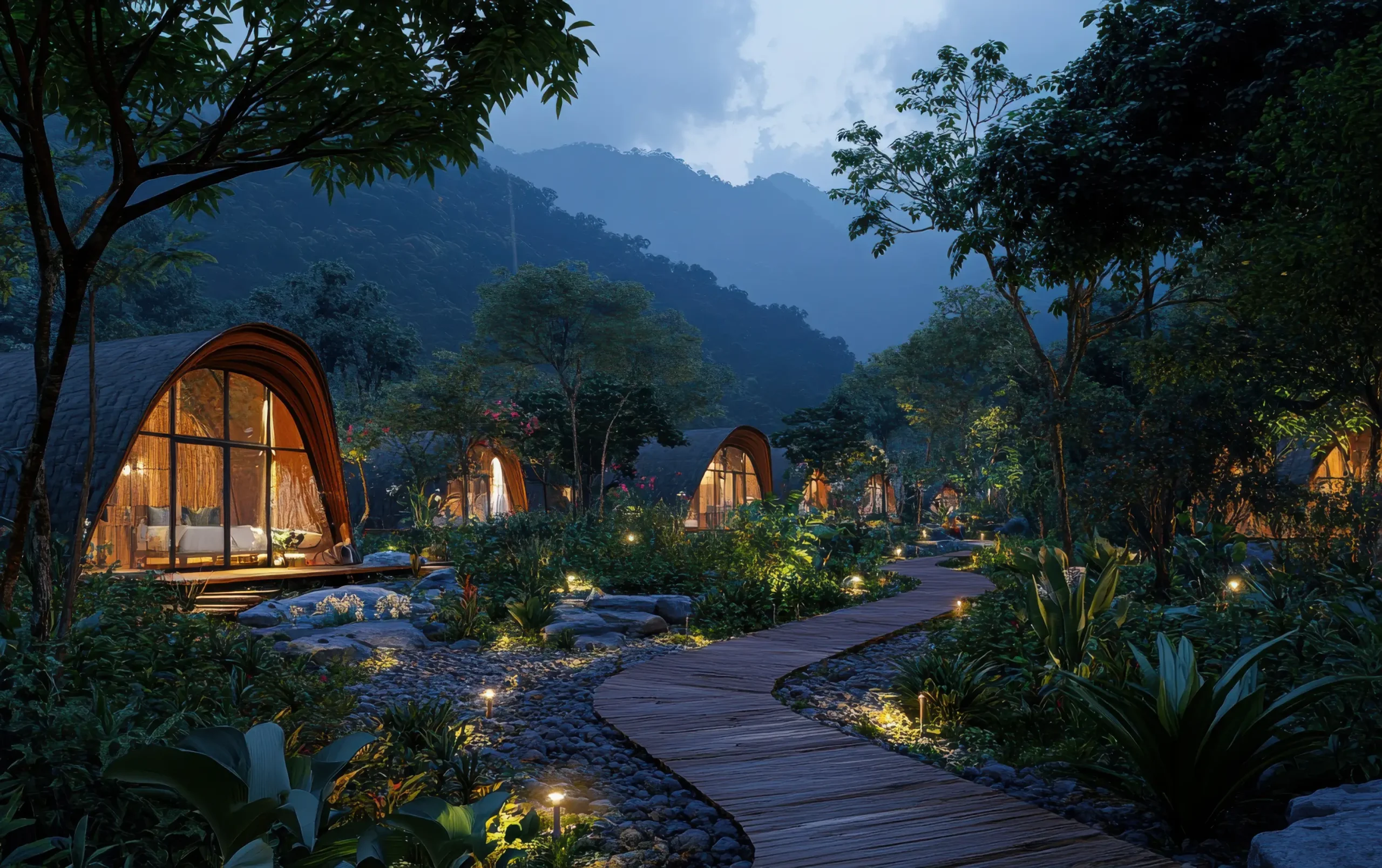Why Bat Friendly Lighting Matters: Protecting Wildlife Through Smarter Environmental Lighting Design
Lighting the Night, Protecting the Wild
Artificial lighting has transformed our night-time environments – improving safety, extending activity hours, and enhancing aesthetics in outdoor spaces. But as our towns and cities grow brighter, a lesser-known cost is emerging: disruption to nocturnal wildlife, especially bats. In the UK, bats play a critical role in insect control and biodiversity, yet their survival is increasingly threatened by excessive and poorly designed lighting.
As lighting designers, specifiers, and consultants, it’s essential to understand how bat friendly lighting can protect sensitive ecosystems while still meeting functional and aesthetic requirements. This article explores the ecological impact of light pollution, outlines best practices for wildlife friendly lighting, and shows how Connected Light delivers smarter, low-impact lighting for even the most sensitive environments – including heritage and listed buildings.
Why Bats and Lighting in the UK Are a Concern
The UK is home to 18 species of bats – 17 of which breed here – making them an integral part of our native ecosystem. As nocturnal animals, bats depend on darkness to forage, navigate, and avoid predators. But with increasing development and the spread of artificial lighting into rural and suburban areas, their habitats are under constant threat.
The issue of bats and lighting in the UK is now well documented. According to the Bat Conservation Trust, artificial light falling near roosts or commuting corridors can delay emergence, reduce foraging time, or even lead to complete roost abandonment. For slower-flying species like lesser horseshoes and Myotis bats, lit areas become barriers, fragmenting feeding grounds and reducing their ability to survive.
“You can’t retrofit biodiversity. Once the habitat is disrupted, it’s often gone for good. That’s why low-impact, ecologically sensitive lighting should be considered at the very start of any outdoor project,” says Matt Holway, Director at Connected Light.
Legally, all UK bat species and their roosts are protected under the Wildlife and Countryside Act 1981 and the Conservation of Habitats and Species Regulations 2010. Any outdoor lighting design near known or potential roosting sites must comply – both ethically and lawfully.
The Impact of Artificial Light on Bats
The growth of Artificial Light at Night (ALAN) has been dramatic – rising by nearly 50% in the past three decades. While the benefits of well-designed exterior lighting are clear, its ecological downsides are becoming harder to ignore. Bats are particularly sensitive, and the effects of inappropriate lighting can be severe.
Exposure to artificial lighting interferes with natural activity cycles. It delays emergence from roosts, shortens foraging periods, and increases the risk of predation. Some species avoid lit areas altogether, forcing them into poorer quality habitats. Even faster species like pipistrelles may be lured to streetlights where insects gather – only to become easier targets for birds of prey.
The science is clear. A 2021 study in ScienceDirect found that short-wavelength light, particularly blue and white LEDs, can significantly reduce bat activity. By contrast, amber or warm-white light (below 2700K) has a far less disruptive effect – making it a central consideration in bat friendly lighting strategies.
These findings reinforce the importance of low impact lighting design – where the right spectrum, intensity, timing, and direction of light are used to minimise ecological disturbance. It’s not about switching off entirely; it’s about lighting with care and intent.
Designing with Bats in Mind: Practical Considerations
Whether you’re lighting a park trail, a car park, or the exterior of a listed building, thoughtful design can make a measurable difference. Here are five key ways to reduce impact while still achieving your lighting goals:
- Light only where needed – Avoid blanket illumination. Every additional light source introduces ecological risk, so lighting schemes should be carefully scoped to focus only on required paths, entrances, and gathering areas. Using cut-off optics or shielded luminaires ensures the beam is directed precisely where it’s needed – reducing waste and preventing unintended consequences for wildlife.
- Use warm or amber tones – Not all light is equal. LEDs with a correlated colour temperature (CCT) of 2700K or lower are significantly less disruptive to nocturnal wildlife, including bats. These warmer hues are less likely to interfere with natural foraging or commuting behaviour and are now widely available in street and architectural lighting products designed for low impact lighting schemes.
- Minimise light spill – Light trespass into dark corridors, hedgerows, watercourses or tree canopies can fragment habitat and reduce foraging areas. Beam angles, mounting height, and luminaire selection should all be chosen to tightly control spread. Spill shields or louvres can help in situations where physical layout makes aiming more challenging.
- Smart control systems – Reducing intensity and operating time is just as important as spectrum. Incorporating presence detection, timers, dimmers, or astronomical clocks ensures light is only present when truly needed. This limits ecological disturbance during peak bat activity (typically 30 minutes after sunset through to the early hours).
- Collaborate early – If bat populations are suspected or confirmed on site, bring in ecological consultants early in the planning process. Understanding roost locations, foraging grounds, and commuting routes helps inform a truly bat friendly lighting layout – one that meets both environmental and operational needs.
For real-world examples of sensitive lighting in action, visit our project portfolio

Balancing Function and Ecology in Outdoor Lighting
It’s a common misconception that sustainable lighting comes at the expense of performance. In reality, well-designed bat friendly lighting can meet both ecological and functional needs – particularly when expert guidance is applied from the outset.
At Connected Light, we don’t treat conservation as a constraint. We see it as part of responsible design. Whether you’re illuminating a heritage estate, upgrading a civic space, or designing for planning compliance, it’s possible to achieve high-quality results that also respect the natural environment.
“Some of our best projects have been the most challenging. When you’re lighting around protected species or in designated landscapes, you’re forced to think creatively – and that’s where great design happens,” says Matt Holway, Director at Connected Light.
A notable example includes the Two Tunnels Greenway near Bath – a sensitive heritage and ecology-led scheme involving extensive underground cycle and pedestrian routes. The project, delivered by Connected Light, involved detailed planning to reduce disruption to bat populations within the tunnels and surrounding environment – proving that elegant, safe lighting and wildlife protection can go hand in hand.
Learn more about our values and team on the About Us page.
Get Support with Bat Friendly Lighting Design
From listed buildings to rural developments, bat friendly lighting is no longer just a “nice to have” – it’s an essential part of modern, sustainable design. Whether you’re navigating planning conditions, working in ecologically sensitive zones, or responding to client concerns about biodiversity, early engagement with the right specialists is key.
Connected Light supports lighting designers, M&E consultants, contractors, and architects with end-to-end guidance on ecologically responsible schemes. Our team can advise on spectrum, controls, fixture selection, and lighting layouts that comply with legislation and best practice – all while enhancing the usability and appearance of your site
If you’re working on a project where wildlife friendly lighting is a factor, don’t leave it to chance. Contact us to ensure your lighting meets both environmental and performance objectives.











